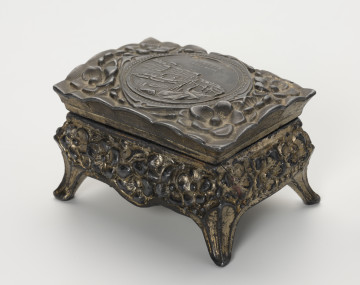
Dessert spoon
1. połowa XX wieku
Museum of the history of Polish Jews
Part of the collection: Pamiątki po żydowskich letnikach
Part of the Marciniak family, who took over the care of the cutlery in the 1990s, also received Jewish summer visitors from Łódź for the summer. In this case, it was a family of small textile and haberdashery traders. The summer visitors rented a room that could be accessed directly from the road, where they carried out their seasonal trade. This family also spent their last holiday in Orchów in 1939. The fact that the seasonal tenancy was maintained by two related families over successive years testifies to the good relations between the Polish landlords and the Jewish summer visitors. However, the donor's account shows that the room, where the tenants carried out seasonal trade, as well as the Jewish cutlery, has not been used by the family until the 1990s, when the granddaughter of the landlords (the donor's aunt) decided to make renovations and incorporate the space into the family's daily use. Tablespoon of silver color, decorated with a geometric motif, plated. Plating is the coating of metal objects with a thin layer of another metal, making them more resistant to external influences (corrosion, abrasion). In the case of household items such as tableware, plating also has a decorative function. Items of this type are usually coated with a thin layer of silver, gold, or alloys (usually of aluminium or copper). Plated wares are known as platings. The manufacturer's signature (punch) 'BR. HENNEBERG' can be seen on the back of the handle of the spoon, indicating Henneberg Brothers Plated and Bronze Goods Factory (founded in 1857). Next are the 'BM' and '90' designations. The first abbreviation means that the object was made of so-called white metal (Britannia pewter, consisitng of circa 92% tin). The number '90' suggests the thickness of the silver layer with which the metal has been coated (90 grams of silver on 24 square decimetres of the product's surface). The handle is decorated with a understated geometric pattern in an art déco style. The decoration consists of three simple transverse grooves placed at its end. After each successive grovve, the shaft narrows to form what appears to be three steps, the narrowest of which is at the edge. |MF
Author / creator
Object type
food and kitchen utensils
Technique
cast, cutting, bending, silver-plating, punching
Material
alloy, silver
Creation time / dating
Creation / finding place
Owner
Muzeum Historii Żydów Polskich POLIN
Identification number
Location / status

1. połowa XX wieku
Museum of the history of Polish Jews

1890 — 1910
National Museum in Szczecin

18th century
Castle Museum in Łańcut
DISCOVER this TOPIC
Museum of King Jan III's Palace at Wilanów
DISCOVER this PATH
Educational path